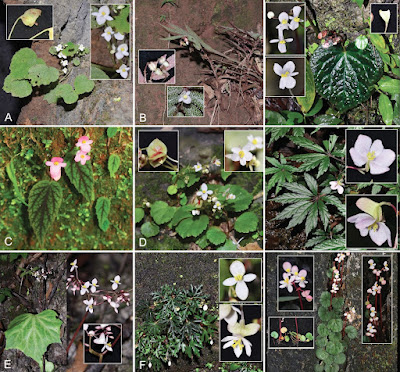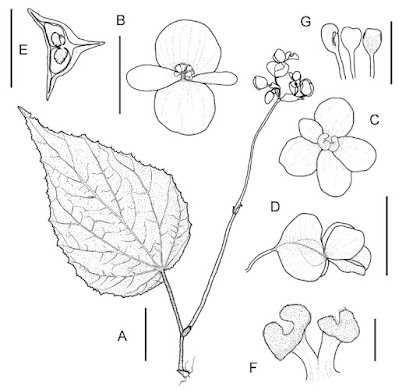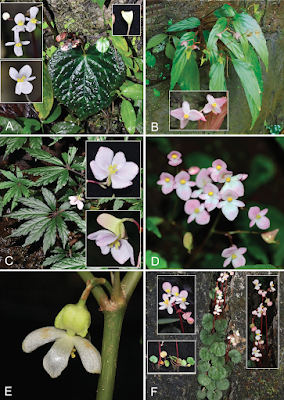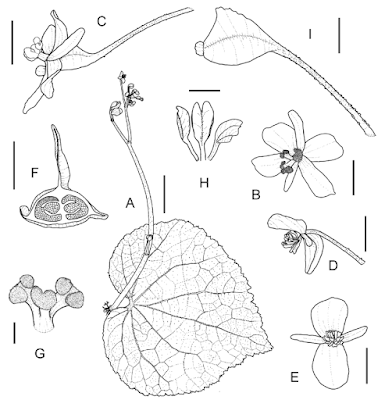[Most Recent Entries] [Calendar View]
Sunday, June 19th, 2022
| Time | Event | ||||
| 10:00a | [Phycology • 2022] Gormaniella terricola • Dynamic Plastid and Mitochondrial Genomes in Chaetopeltidales (Chlorophyceae) and Characterization of A New Chlorophyte Taxon
Abstract Premise: Chaetopeltidales is a poorly characterized order in the Chlorophyceae, with only two plastid and no mitochondrial genomes published. Here we describe a new taxon in Chaetopeltidales, Gormaniella terricola gen. et sp. nov. and characterize both of its organellar genomes. Methods: Gormaniella terricola was inadvertently isolated from a surface-sterilized hornwort thallus. Light microscopy was used to characterize its vegetative morphology. Organellar genomes were assembled, annotated, and analyzed using a variety of software packages. Results: The mitochondrial genome (66,927 bp) represents the first complete mitochondrial genome published for Chaetopeltidales. The chloroplast genome, measuring 428,981 bp, is one of the largest plastid genomes published to date and shares this large size and an incredible number of short, dispersed repeats with the other sequenced chloroplast genomes in Chaetopeltidales. Despite these shared features, the chloroplast genomes of Chaetopeltidales appear to be highly rearranged when compared to one another, with numerous inversions, translocations, and duplications, suggesting a particularly dynamic chloroplast genome. Both the chloroplast and mitochondrial genomes of G. terricola contain a number of mobile group I and group II introns, which appear to have invaded separately. Three of the introns within the mitochondrial genome encode homing endonucleases that are phylogenetically nested within those found in fungi, rather than algae, suggesting a possible case of horizontal gene transfer. Conclusions: These results help to shed light on a poorly understood group of algae and their unusual organellar genomes, raising additional questions about the unique patterns of genome evolution within Chaetopeltidales. Keywords: algae, chloroplast genome, Gormaniella, intron, mitogenome, repeats Gormaniella terricola Tanner Robison, Jessica M. Nelson, Duncan A. Hauser, Louise A. Lewis and Fay-Wei Li. 2022. Dynamic Plastid and Mitochondrial Genomes in Chaetopeltidales (Chlorophyceae) and Characterization of A New Chlorophyte Taxon. American Journal of Botany. DOI: 10.1002/ajb2.16015 New species of alga named for poet Amanda Gorman | ||||
| 10:43a | [Ichthyology • 2022] Phylogenomic Analysis of the Neotropical Fish Subfamily Characinae (Characiformes: Characidae) using Ultraconserved Elements Highlights • First phylogenomic study of the Neotropical fish subfamily Characinae. • Characinae and six genera are monophyletic. • A novel hypothesis of intergeneric and interspecific to Characinae. • A new tribe is proposed to allocate Acanthocharax. • Subclades are proposed for Phenacogaster, Cynopotamus and Charax. Abstract Characinae is one of the most species-rich subfamilies of Characidae and holds special taxonomic importance because it includes Charax, type-genus of Characidae and Characiformes. Currently, the monophyly and the hypotheses of intergeneric and interspecific relationships of Characinae are based on a few morphological and molecular studies but all with low species coverage. Given their diversity, taxonomic importance, and the lack of a taxon-dense phylogeny, we sought to buttress the systematic understanding of Characinae collecting DNA sequence data from ultraconserved elements (UCEs) of the genome from 98 specimens covering 57 species (61%) plus 17 characiforms as outgroups. We used maximum likelihood, Bayesian inference, and coalescent-based species tree approaches and the resulting phylogeny with 1,300 UCE loci (586,785 characters) reinforced the monophyly of the subfamily as well as of six genera: Acestrocephalus, Charax, Cynopotamus, Galeocharax, Phenacogaster, and Roeboides. The phylogeny provides a hypothesis of intergeneric and interspecific relationships for the subfamily with Phenacogaster sister to all genera, and Acanthocharax sister to Cynopotamini (Cynopotamus (Acestrocephalus Galeocharax)) and Characini (Charax Roeboides). We propose a new tribe Acanthocharacini to allocate Acanthocharax, two subclades for Phenacogaster, two for Cynopotamus, three for Charax, and reinforced the four subclades for Roeboides previously identified by morphological studies. Additionally, we generated a time-calibrated phylogeny for Characinae that suggested an initial diversification during the Miocene at around 19 million years ago and discussed historical biogeographic events for major subclades. The results obtained here will contribute to the development of further research on the evolutionary processes modulating species diversification in Characinae. Keywords: Biodiversity, Characiformes, Freshwater fish, Neotropics, Ostariophysi, Systematics Camila S. Souza, Bruno F. Melo, George M. T. Mattox and Claudio Oliveira. 2022. Phylogenomic Analysis of the Neotropical Fish Subfamily Characinae using Ultraconserved Elements (Teleostei: Characidae). Molecular Phylogenetics and Evolution. 171, 107462. DOI: 10.1016/j.ympev.2022.107462 | ||||
| 2:59p | [Botany • 2021] Begonia glabritepala, B. lanxangensis, B. viriditenebris, etc. • Seven New Species and Seven New Records of Begonia L. (Begoniaceae) in the Flora of Laos Abstract New species of Begonia L. in the flora of Laos presented in this paper were mainly found in the course of botanical surveys made in Hin Nam No National Protected Area, Nam Phouy National Protected Area, Khammouane Karst Forest, and Phou Khao Khouay National Protected Area.Additionally, herbaria presently available in Laos (HNL, FOF, NUoL, FRC), living plants, and alcohol preserved material at Pha Tad Ke Botanical Garden and the data accessible online at BM, E, K, LE, NY, P, and PE Herbaria were critically studied. The study conducted during 2012–2019 reveals seven new species for science and seven species newly recorded for the flora of Lao PDR. Species described as new for science are: Begonia glabritepala (found in Khammouane Province; it is most close to B. pierrei but differs in glabrous outer tepals of staminate flowers, pistillate flowers, capsules, petioles, peduncles and pedicles), B. heterocantha (found in Sainyabuli Province; most close to B. depingiana but differs in reddish purple, glandular pubescent abaxial leaf surface, glandular pubescent pedicel, and outer tepals of pistillate flowers sparsely white glandular pubescent), B. lanxangensis (found in Vientiane Province; most close to B. paleacea but differs in elongate tubers, ovate-lanceolate, obscurely asymmetrical to symmetrical leaves, and glabrous pedicels), B. parviglandulosa (found in Vientiane Province; most close to B. martabanica but differs in smaller habit, reniform-cordate leaves and glandular indumentum on peduncle, pedicle and capsules), B. pseudobrandisiana (found in Khammouane Province; most close to B. brandisiana but differs in pistillate flowers with five elliptic-oblanceolate tepals), B. tripartifolia (found in Khammouane Province; most close to B. tricuspidata but differs in leaves palmate triangular-ovate, with deeply lobed lacerate margin, pistillate flower of five tepals, and ovary with unequal wing), and B. viriditenebris (found in Khammouane Province; most close to B. sinuata but differs in single leaf, indumentum of bristle hairs and reddish or bronzy green adaxial leaf surface, and three styles). The following species discovered and recorded for the flora of Laos at first are: B. hatacoa (known in Nepal, Bhutan, NE India, Myanmar, Thailand, and Vietnam), B. hemsleyana (China, Vietnam), B. labordei (NE India, Myanmar, S China, Vietnam), B. longifolia (tropical zone from NE India to Indonesia), B. minuscula (Vietnam), B. parvula (S China), and B. subperfoliata (Myanmar, Thailand, S Vietnam). Descriptions and line drawings are provided for all newly described species. Photographic illustrations, data on phenology, habitat, and notes on morphological variations and relations are given for all studied species. Keywords: local endemism, new species, plant diversity, plant taxonomy, Indochine Begonia glabritepala Souvann. et Lanors., sp. nov. (B. sect. Reichenheimia (Klotzsch) A. DC.) Diagnosis. The species is similar to B. pierrei Gagnep. in habit but differs in having glabrous outer tepals of staminate flowers, pistillate flowers, capsules, petioles, peduncles, and pedicles (vs. all mentioned plant parts pilose) (Fig. 1, 2A). — The specific epithet refers to glabrous tepals. Distribution. This species is endemic to Hin Nam No National Protected Area (Khammouane Province, Boualapha District). Ecology and phenology. Wet rock crevices in humid places of limestone deciduous forest. Flowers from August to October, fruits in October. Vernacular name. Som Saeng Pha (hill begonia). Begonia heterocantha Souvann. et Lanors., sp. nov. (B. sect. Lauchea (Klotzsch) A. DC.) Diagnosis. This species is close to B. depingiana Y. H. Tan et H. B. Ding in its tuberiferous habitus, distichous alternate leaves, and 3-locular ovary (Hong-Bo et al., 2020b). From mentioned species, it differs in reddish purple, glandular pubescent abaxial leaf surface (vs. abaxial surface light green, densely white villous), glandular pubescent pedicel (vs. pedicel puberulous), and outer tepals of pistillate flowers sparsely white glandular pubescent (vs. tepals almost glabrous, light pinkish) (Fig. 2B, 3). — The specific epithet refers to dorsal wing of capsule that looks like broad spine. Distribution. Endemic to Nam Phouy National Protected Area (Sainyabuli Province, Thongmixai District). Ecology and phenology. Wet sandy soil in deciduous forest mixed with bamboo. Flowers in September, fruits in October. Vernacular name. Som Koung Khao Dang (white speckled begonia). Begonia lanxangensis Souvann. et Aver., sp. nov. (B. sect. Monophyllon A. DC.) Diagnosis. This species is closest to B. paleacea Kurz in having inflorescences arising from the base of the leaves, but it differs in having elongate tubers (vs. tubers globose), ovate-lanceolate, obscurely asymmetrical to symmetrical leaves (vs. leaves distinctly asymmetrical, ovate to orbiculate), and glabrous pedicels (vs. pedicels glandular pubescent) (Fig. 2C, 4). — The species epithet refers the old name of Lao PDR, which means “Kingdom of million elephants”, as well as Phou Khao Khouay National Protected Area is one of a few elephant habitats still existing in the country. Distribution. Known only from type locality at Phou Khao Khouay National Protected Area (Vientiane Province). Ecology and phenology. Moist mossy rocks in seasonally dry evergreen forest mixed with bamboo on the hill slopes. Flowers in May – June. Vernacular name. Som Koung Lane Xang (million elephant begonia). Begonia parviglandulosa Souvann. et Lanors., sp. nov. (B. sect. Parvibegonia A. DC.) Diagnosis. The plant is most similar to B. martabanica A. DC. but differs in smaller habitus, reniform-cordate leaves (vs. leaves ovate), peduncle, pedicle and capsules with glandular hairs (vs. pubescent with simple hairs) (Fig. 2D, 5). — The specific epithet refers characteristic glandular indumentum. Distribution. Endemic of Phou Khao Khouay National Protected Area (Vientiane Province). Ecology and phenology. Moist mossy rocks in seasonally dry evergreen forest mixed with bamboo near stream. Flowers in July – October, fruits in October – November. Vernacular name. Som Koung Noi (weed begonia). Begonia pseudobrandisiana Souvann. et Lanors., sp. nov. (B. sect. Reichenheimia (Klotzsch) A. DC.) Diagnosis. The new species is similar to B. brandisiana Kurz but differs in pistillate flowers having five tepals (vs. pistillate flowers with two tepals), outer pairs of tepals of both staminate and pistillate flowers elliptic-oblanceolate (vs. tepals orbiculate) (Fig. 2E, 6). — The specific epithet refers to the superficial similarity of the new species with Begonia brandisiana. Distribution. This species known only from Tham Nang Ene Cave Preserved Area (Khammouane Province, Thakheak District). Ecology and phenology. Rock on limestone hills covered by deciduous forest in association with Globba sp., Zingiber sp., Impatiens sp., and Argostemma sp. Flowers in June – August, fruits in July – September. Vernacular name. Som Koung Bai Dok Thong (butea leaf begonia). Begonia tripartifolia Souvann. et Lanors., sp. nov. (B. sect. Reichenheimia (Klotzsch) A. DC.) Diagnosis. The species is similar to B. tricuspidata C. B. Clarke from B. sect. Alicida C. B. Clarke but differs in having leaves palmate triangular-ovate, with deeply lobed lacerate margin (vs. leaves ovate with almost entire or crenate margin), pistillate flower with five tepals (vs. pistillate flowers with four tepals), ovary with unequal wings, dorsal wing smaller, triangular, lateral wings broadly lunate (vs. ovary with subequal wings) (Fig. 2F, 7). — The specific epithet means deeply lobed, mainly tripartite leaves. Distribution. Endemic of Mahaxay Karst Area (Khammouane Province, Mahaxay District). Ecology and phenology. Limestone rocks on wet slopes in open forest or scrub in association with Microchirita sp., Argostemma sp., and Adiantum sp. Vernacular name. Som Koung Bai Seak (deeply lobe-leaved begonia). Begonia viriditenebris Lanors. et Souvann., sp. nov. (B. sect. Parvibegonia A. DC.) Diagnosis. This new species is similar to B. sinuata Wall. ex Meisn. but differs in single leaf, indumentum of bristle hairs and reddish or bronzy green adaxial leaf surface (vs. two-three leaves, indumentum of stellate hairs and dark green adaxial surface of leaf), three styles (vs. two styles), and glandular hairy pedicels (vs. pedicels with stellate hairs) (Fig. 8, 9A). — The specific epithet means the bronzy-green leaf color. Distribution. Endemic to Tham Nang Ene Cave area (Khammoune Province, Thakheak District). Ecology and phenology. Wet limestone and granite rock in association with Asplenium sp., Adiantum sp., Globba sp., and Zingiber sp. Flowers in June – August, fruits in September – October. Vernacular name. Som Koung Tham (cave begonia). Keooudone Souvannakhoummane, Soulivanh Lanorsavanh and Leonid V. Averyanov. 2021. Seven New Species and Seven New Records of Begonia L. (Begoniaceae) in the Flora of Laos. Turczaninowia. 24(2); 99-119. DOI: 10.14258/turczaninowia.24.2.12 | ||||
| 3:12p | [Botany • 2022] Dyckia pseudodelicata (Bromeliaceae: Pitcairnioideae) • A New Species of the D. selloa complex from Rio Grande do Sul, Brazil
Abstract We propose the new species Dyckia pseudodelicata which is described and illustrated here, and provide data on its distribution and habitat. We compare the new species to the related Dyckia delicata and highlight their morphological differences. Morphological features that have been little explored in Dyckia taxonomy proved to be diagnostic in our analysis, such as the presence and morphology of trichomes on the petal margins and the position of ovules in relation to the longitudinal axis of the ovary and their disposition in the placenta. Keywords: bromeliads, Dyckia delicata, monocots, taxonomy, xerophytes
Dyckia pseudodelicata Büneker & Mariath, sp. nov. Etymology:—The specific epithet “pseudodelicata” refers to the vegetative similarity between the new species and D. delicata. The new species was not flowering when first collected and was believed to be D. delicata. However, significant morphological differences found after checking its inflorescences revealed it to be a new species, which we decided to call “false” D. delicata. Henrique Mallmann Büneker and Jorge Ernesto de Araujo Mariath. 2022. Dyckia pseudodelicata, A New Species of the D. selloa complex (Bromeliaceae, Pitcairnioideae) from Rio Grande do Sul, Brazil. Phytotaxa. 550(1); 59-70. DOI: 10.11646/phytotaxa.550.1.4 |
| << Previous Day |
2022/06/19 [Calendar] |
Next Day >> |









